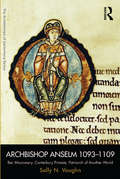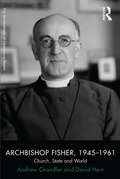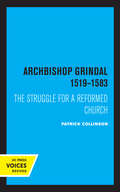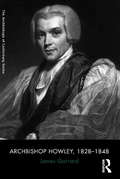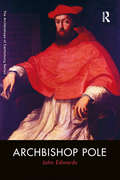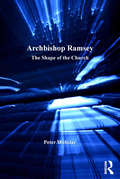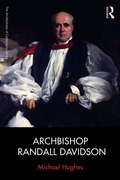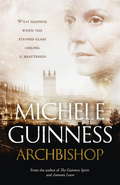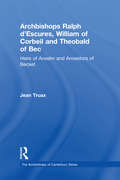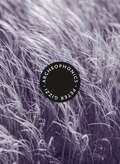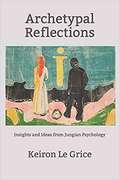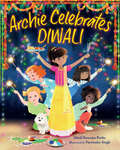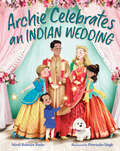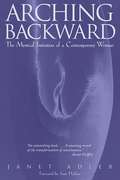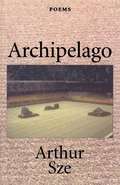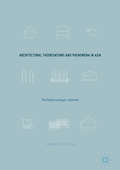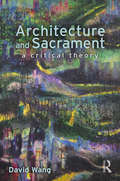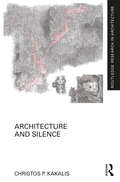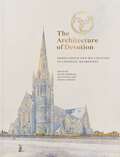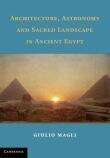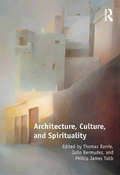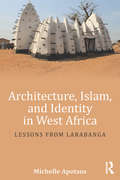- Table View
- List View
Archbishop Anselm 1093–1109: Bec Missionary, Canterbury Primate, Patriarch of Another World (The Archbishops of Canterbury Series)
by Sally N. VaughnSt Anselm's archiepiscopal career, 1093-1109, spanned the reigns of two kings: William Rufus and the early years of Henry I. As the second archbishop of Canterbury after the Norman Conquest, Anselm strove to extend the reforms of his teacher and mentor at Bec, and his predecessor at Canterbury, Archbishop Lanfranc. Exploring Anselm's thirty years as Prior and Abbot of the large, rich, Norman monastery of Bec, and teacher in its school, this book notes the wealth of experiences which prepared Anselm for his archiepiscopal career--in particular Bec's missionary attitude toward England. Sally Vaughn examines Anselm's intellectual strengths as a teacher, philosopher and theologian: exploring his highly regarded theological texts, including his popular Prayers and Meditations, and how his statesmanship was influenced as he dealt with conflict with the antagonistic King William Rufus. Vaughn argues that Rufus's death influenced Anselm's rivalry with King Henry I and fostered a more subdued and civil conflict between Anselm and Henry which ended with cooperation between king and archbishop at the end of Anselm's life. King and archbishop became’yoked together as two oxen pulling the plow of the church through the land of England’. Anselm’s final years at the pinnacle of power reveal a superb administrator over Canterbury and Primate over the churches of all Britain, in which position his followers described him as 'Pope of another world'. The final section includes a selection of original source material including archiepiscopal letters drawn primarily from Lambeth Palace Library.
Archbishop Fisher, 1945–1961: Church, State and World (The Archbishops of Canterbury Series)
by David Hein Andrew ChandlerArchbishop Fisher’s archiepiscopate reflected the central issues of his time and place. It was Fisher who oversaw an immense programme of reforms which effectively recast the institutions of the Church of England for generations to come. It was Fisher who proved to be the essential architect, politician and diplomat behind the creation of a worldwide Anglican Communion. His determination to promote the development of relations with other churches produced a vital contribution to the cause of ecumenism, which culminated in his momentous meeting with Pope John XXIII. Archbishop Fisher was a vigorous participant in the questions which defined national and international life. This book explores Fisher’s influence on major contemporary issues and events, including divorce-law reform and capital punishment at home and the end of Empire and the most dangerous years of the Cold War abroad. This new biography establishes the continuing significance not only of the office of Archbishop in the Church but also of the Church at large in the tumultuous world of the later twentieth century. A final section of original source material includes letters, sermons and other writings bringing vividly to life the range and character of Fisher's public and private role.
Archbishop Grindal, 1519-1583: The Struggle for a Reformed Church
by Patrick CollinsonThis title is part of UC Press's Voices Revived program, which commemorates University of California Press’s mission to seek out and cultivate the brightest minds and give them voice, reach, and impact. Drawing on a backlist dating to 1893, Voices Revived makes high-quality, peer-reviewed scholarship accessible once again using print-on-demand technology. This title was originally published in 1977.
Archbishop Howley, 1828-1848 (The Archbishops of Canterbury Series)
by James GarrardWilliam Howley, Archbishop of Canterbury 1828-1848, led the Church of England during the beginning and expansion of the Oxford Movement, at a time when the precursor to the Church Commissioners was established, and during the momentous debates and decisions in Parliament which saw the final retreat from the myth of an all Anglican legislature. Howley’s chairmanship of the commissions of the 1830s and 1840s which began the gargantuan task of reforming the Church’s practices and re-arranging its finances, made him an object of fury and scorn to some of those who benefited from things as they were, most especially in the cathedrals. Exploring the central events and debates within the Church of England in the first half of the nineteenth century, this book draws on primary and secondary evidence about Howley’s career and influence. A section of original sources, including his Charges and other public documents, correspondence and speeches in the House of Lords, places Howley’s achievements in proper context and illustrates his prevailing concerns in education, the establishment and political reform, relationships with the Tractarians, and in the early stages of Church reform. Dealing thematically with many of the issues faced by Howley, and exploring his own High Church theological views in historical context, James Garrard offers a fruitful re-appraisal of the intellectual, spiritual and ’party’ context in which Howley moved.
Archbishop Pole (The Archbishops of Canterbury Series)
by John EdwardsThis fresh exploration of the life, work and writing of Archbishop Pole, focuses particularly on Pole’s final years (1556-58) as Archbishop of Canterbury. Fully integrating Pole’s English and Continental European experiences, John Edwards places these in their historical context and signposts lessons for contemporary issues and concerns. Stressing the events and character of Pole's 'English' life, up to his exile in the 1530s, as well as in his final years in England (1554-58), this book explores his close relationship, both genealogical and emotional, with Henry VIII and Mary I. Portraying Pole as a crucial figure in the Catholic-Protestant division, which still affects Britain today, this book details the first, and so far last, attempt to restore Roman Catholicism as the 'national religion' of England and Wales by telling the life-story of the hinge figure in forging English religious and political identity for several centuries. The final section of this book draws together important and illuminating source material written by Pole during his years as Archbishop of Canterbury.
Archbishop Ramsey: The Shape of the Church (The Archbishops of Canterbury Series)
by Peter WebsterArchbishop Michael Ramsey’s archiepiscopate from 1961 to 1974 saw profound renegotiations of the relationship of the Church of England with its own flock, with the nation more widely, with the Anglican church worldwide, and with the other Christian churches. Drawing from unique source material in the Lambeth Palace Library archives and reproducing many original writings of Ramsey for the first time, this book explores key questions which surround Ramsey’s tenure. How did Ramsey react to the rapid hollowing-out of the regular constituency of the church whilst at the same time seeing sweeping changes in the manner in which the church tried to minister to those members? What was his role in the widening of the church's global vision, and the growing porousness of its borders with other denominations? And how did the nature of the role of archbishop as figurehead change in this period?
Archbishop Randall Davidson (The Archbishops of Canterbury Series)
by Michael HughesRandall Davidson was Archbishop of Canterbury for quarter of a century. Davidson was a product of the Victorian ecclesiastical and social establishment, whose advance through the Church was dependent on the patronage of Queen Victoria, but he became Archbishop at a time of huge social and political change. He guided the Church of England through the turbulence of the Edwardian period, when it faced considerable challenges to its status as the established Church, as well as helping shape its response to the horrors of the First World War. Davidson inherited a Church of England that was sharply divided on a range of issues, and he devoted his career as Archbishop to securing its unity, whilst ensuring that its voice continued to be heard both nationally and internationally. A modest and pragmatic man, he was widely respected both within the Church of England and beyond, helping to find solutions to a range of political and ecclesiastical problems. This book explores Davidson’s role within the Church and in the life of Britain more broadly during his time at Canterbury. It includes a large selection of documents that help to reveal the Archbishop’s character and cast light on the way in which he carried out his varied and demanding duties.
Archbishop: A Novel
by Michele GuinnessFive years from now, the Church of England is on its knees. Yet one woman is making a difference, and when she is appointed Archbishop of Canterbury, anything could happen.Vicky Burnham-Woods is a master of diplomacy, and deeply committed to bringing the church back into the heart of community and cultural life - but not everyone wants a woman at the top, and behind the scenes dark forces are moving.Can the first ever female Archbishop of Canterbury last long enough to achieve her mission?
Archbishop: A novel
by Michele GuinnessFive years from now, the Church of England is on its knees. Yet one woman is making a difference, and when she is appointed Archbishop of Canterbury, anything could happen.Vicky Burnham-Woods is a master of diplomacy, and deeply committed to bringing the church back into the heart of community and cultural life - but not everyone wants a woman at the top, and behind the scenes dark forces are moving.Can the first ever female Archbishop of Canterbury last long enough to achieve her mission?
Archbishops Ralph d'Escures, William of Corbeil and Theobald of Bec: Heirs of Anselm and Ancestors of Becket (The Archbishops of Canterbury Series)
by Jean TruaxThe first two archbishops of Canterbury after the Norman Conquest, Lanfranc and Anselm, were towering figures in the medieval church and the sixth archbishop, the martyred Thomas Becket, is perhaps the most famous figure ever to hold the office. In between these giants of the ecclesiastical world came three less noteworthy men: Ralph d'Escures, William of Corbeil, and Theobald of Bec. Jean Truax's volume in the Ashgate Archbishops of Canterbury Series uniquely examines the pontificates of these three minor archbishops. Presenting their biographies, careers, thought and works as a unified period, Truax highlights crucial developments in the English church during the period of the pontificates of these three archbishops, from the death of Anselm to Becket. The resurgent power of the papacy, a changed relationship between church and state and the expansion of archiepiscopal scope and power ensured that in 1162 Becket faced a very different world from the one that Anselm had left in 1109. Selected correspondence, newly translated chronicle accounts and the text and a discussion of the Canterbury forgeries complete the volume.
Archeophonics (Wesleyan Poetry Ser.)
by Peter GizziSoulful and intricate lyrics make this Gizzi's strongest book to dateArcheophonics is the first collection of new work from the poet Peter Gizzi in five years. Archeophonics, defined as the archeology of lost sound, is one way of understanding the role and the task of poetry: to recover the buried sounds and shapes of languages in the tradition of the art, and the multitude of private connections that lie undisclosed in one's emotional memory. The book takes seriously the opening epigraph by the late great James Schuyler: "poetry, like music, is not just song." It recognizes that the poem is not a decorative art object but a means of organizing the world, in the words of anthropologist Clifford Geertz, "into transient examples of shaped behavior." Archeophonics is a series of discrete poems that are linked by repeated phrases and words, and its themes and nothing less than joy, outrage, loss, transhistorical thought, and day-to-day life. It is a private book of public and civic concerns.
Archetypal Reflections: Insights And Ideas From Jungian Psychology
by Keiron Le GriceIn this book, Keiron Le Grice shares his expertise in depth psychology and its central preoccupation: the workings of the unconscious mind. Adapted from his teaching in the Jungian and Archetypal Studies specialization at Pacifica Graduate Institute, California, Archetypal Reflections provides concise paragraph-length analyses and explanations of a wide range of topics, focusing on the work of C. G. Jung and other influential figures such as Nietzsche, Freud, Campbell, and Hillman. Skillfully illuminating Jung's theories of archetypes, individuation, the Self, and synchronicity, Le Grice also explores a number of other fascinating topics such as the role of the unconscious and myth in modern culture, the evolution of consciousness and civilization, the quest for spiritual meaning in a secular age, and the intersection of depth psychology and the new sciences. The primary concern throughout is the capacity of depth psychology to inform and transform our worldview, addressing the question of how we might find greater meaning and spiritual fulfillment in life. Le Grice shows how Jungian ideas can provide a source of deep wisdom to inform the inner journey and help us to better understand our place in the larger scheme of things.
Archie Celebrates Diwali
by Mitali Banerjee RuthsIt's Archie's favorite holiday—Diwali. And this year she gets to share it with her friends and introduce them to the festival of lights!Archana loves her family's annual Diwali (deh-vah-lee) party, and this year she gets to share it with all her friends from school. She helps with the decorations and the food, and is eager for everyone to arrive. But once the party starts a thunderstorm kicks up and drenches the outside decorations and knocks out the power. Archie worries that everything will be ruined. How can there be a festival of lights without any electricity?
Archie Celebrates an Indian Wedding
by Mitali Banerjee RuthsKindhearted Archie is back! Her Poppy Uncle is getting married in a big Indian wedding, and Archie and new friend Emma realize that love and fun are universal.In this cross-cultural friendship story, Archie helps Emma, who isn&’t Indian, learn everything she needs to know when Archie&’s Poppy Uncle and Emma&’s Auntie Julie get married. The girls go to the mehendi party and sangeet together. They help Julie at the wedding, steal Poppy&’s shoes, and eat ladoos at the reception. Now Archie and Emma are friends—and cousins!Archie&’s adventures celebrate Indian culture! We first met Archie in Archie Celebrates Diwali and now join her in the follow-up Archie Celebrates an Indian Wedding. Backmatter in Archie's books feature kid-friendly resources to enrich the reading experience.
Arching Backward: The Mystical Initiation of a Contemporary Woman
by Janet AdlerArching Backward is the story of an American woman who found herself suddenly and violently immersed in a mystical initiation for which she was not consciously prepared. For four years, Janet Adler's life was dominated by the transforming experience of a primal energy and the visions that were created by it. She was not seeking spiritual experience, nor was she a student of any particular mystical tradition. But the visions brought her into the realm of the sacred, transforming her body into a conduit for spiritual energy. The writings collected here record her visions and describe the way this contemporary woman dealt with the impact of this energy on her physical body, her work, and her relationships. Her story offers a guide for others on this journey and provides a powerful affirmation of women's experience of the spirit.
Archipelago
by Arthur SzeArthur Sze has captured what it means to be a Chinese-American through a book of poems. Sze's poetry moves beyond issues and questions of culture and into the natural world.
Architectural Theorisations and Phenomena in Asia: The Polychronotypic Jetztzeit
by Francis Chia-Hui LinThis book is the first overall and detailed discussion of contemporary Asia's architectural theorisations and phenomena based on its heteroglossic and decolonisation character. Lin presents a theoretical journey of transdisciplinary reflection upon contemporary Asia's pragmatic phenomena which is methodologically achieved by means of elaborations of how tangible Asian architecture can be philosophically theorised and how interchangeable architectural theory is practically 'Asianised'. Discussions in the book are critically integrated with comparative studies focused on Japan, Taiwan, China, Hong Kong, Singapore, Malaysia, Australia, New Zealand and the UK. These empirical examinations are highlights of phenomenal localities, architecture, cities and cultures which reference the historicity of the Asia Pacific, Asia's contemporary architectural situations, and their subtle relationship with the 'West'. The schematisation of intended 'fuzziness' for Asia and its architecture is framed as the notion polychronotypic jetztzeit to represent a present time-place context of contemporary Asian architecture and urbanism. This book will be of great interest to scholars of Asian Studies, Architectural Studies, Postcolonial Studies, Urban Studies and Cultural Studies.
Architecture and Ritual in the Churches of Constantinople
by Vasileios MarinisThis book examines the interchange of architecture and ritual in the Middle and Late Byzantine churches of Constantinople (ninth to fifteenth centuries). It employs archaeological and archival data, hagiographic and historical sources, liturgical texts and commentaries, and monastic typika and testaments to integrate the architecture of the medieval churches of Constantinople with liturgical and extra-liturgical practices and their continuously evolving social and cultural context. The book argues against the approach that has dominated Byzantine studies: that of functional determinism, the view that architectural form always follows liturgical function. Instead, proceeding chapter by chapter through the spaces of the Byzantine church, it investigates how architecture responded to the exigencies of the rituals, and how church spaces eventually acquired new uses. The church building is described in the context of the culture and people whose needs it was continually adapted to serve. Rather than viewing churches as frozen in time (usually the time when the last brick was laid), this study argues that they were social constructs and so were never finished, but continually evolving.
Architecture and Sacrament: A Critical Theory
by David WangDavid Wang’s Architecture and Sacrament considers architectural theory from a Christian theological perspective, specifically, the analogy of being (analogia entis). The book tracks social and cultural reasons why the theological literature tends to be separate from contemporary architecture theory. Wang argues that retrieval of the sacramental outlook embedded within the analogy of being, which informed centuries of art and architecture in the West, can shed light on current architectural issues such as "big box stores," the environmental crisis and the loss of sense of community. The book critiques the materialist basis of current architectural discourse, subsumed largely under the banner of critical theory. This volume on how European ideas inform architectural theory complements Wang’s previous book, A Philosophy of Chinese Architecture: Past, Present, Future, and will appeal to architecture students and academics, as well as those grappling with the philosophical moorings of all built environments.
Architecture and Silence (Routledge Research in Architecture)
by Christos P. KakalisThis book explores the role of silence in how we design, present and experi-ence architecture. Grounded in phenomenological theory, the book builds on historical, theoretical and practical approaches to examine silence as a methodological tool of architectural research and unravel the experiential qualities of the design process. Distinct from an entirely soundless experience, silence is proposed as a material condition organically incorporated into the built and natural landscape. Kakalis argues that, either human or atmospheric, silence is a condition of waiting for a sound to be born or a new spatio-temporal event to emerge. In silence, therefore, we are attentive and attuned to the atmos-phere of a place. The book unpacks a series of stories of silence in religious topographies, urban landscapes, film and theatre productions and architec-tural education with contributed chapters and interviews with Jeff Malpas and Alberto Pérez-Gómez. Aimed at postgraduate students, scholars and researchers in architectural theory, it shows how performative and atmospheric qualities of silence can build a new understanding of architectural experience.
Architecture of Devotion: James Goold and His Legacies in Colonial Melbourne
by Jaynie Anderson Max Vodola Shane CarmodyThe Architecture of Devotion: James Goold and His Legacies in Colonial Melbourne honours the life and cultural contribution of Archbishop James Alipius Goold (1812-1886). Goold arrived in 1848 as the first Catholic bishop of the newly created diocese of Melbourne and quickly adapted to Australian colonial conditions, setting about establishing an extraordinary network of schools, churches and welfare institutions across Victoria. Beyond the immediate task of building bluestone, bricks and mortar, Goold carried a grand vision, sensing that Melbourne was on its way to becoming a grand international metropolis. A collector and man of refined taste, Goold not only adorned religious institutions with quality Baroque artwork, but he also amassed a unique book collection and private library that showcased his European cultural sensibilities. A companion to The Invention of Melbourne: A Baroque Archbishop and a Gothic Architect (2019), The Architecture of Devotion brings Goold to life as we follow him around the colony and witness how he shaped the fabric of Victorian suburbs and towns. These volumes have been supported by the Australian Research Council, which has recognised them as among the best research projects in Australia.The Invention of Melbourne was commended in the Victorian Community History Award 'History Publication Award', 2020.
Architecture of the Sacred
by Bonna D. Wescoat Robert G. OusterhoutIn this book, a distinguished team of authors explores the way space, place, architecture and ritual interact to construct sacred experience in the historical cultures of the eastern Mediterranean. Essays address fundamental issues and features that enable buildings to perform as spiritually transformative spaces in ancient Greek, Roman, Jewish, early Christian and Byzantine civilizations. Collectively they demonstrate the multiple ways in which works of architecture and their settings were active agents in the ritual process. Architecture did not merely host events; rather, it magnified and elevated them, interacting with rituals facilitating the construction of ceremony. This book examines comparatively the ways in which ideas and situations generated by the interaction of place, built environment, ritual action and memory contributed to the cultural formulation of the sacred experience in different religious faiths.
Architecture, Astronomy and Sacred Landscape in Ancient Egypt
by Giulio MagliThis book examines the interplay between astronomy and dynastic power in the course of ancient Egyptian history, focusing on the fundamental role of astronomy in the creation of the pyramids and the monumental temple and burial complexes. Bringing to bear the analytical tools of archaeoastronomy, a set of techniques and methods that enable modern scholars to better understand the thought, religion, and science of early civilizations, Giulio Magli provides in-depth analyses of the pyramid complexes at Giza, Abusir, Saqqara, and Dahshur, as well as of the Early Dynastic necropolis at Abydos and the magnificent new Kingdom Theban temples. Using a variety of data retrieved from study of the sky and measurements of the buildings, he reconstructs the visual, symbolic, and spiritual world of the ancient Egyptians and thereby establishes an intimate relationship among celestial cycles, topography, and architecture. He also shows how they were deployed in the ideology of the pharaoh's power in the course of Egyptian history.
Architecture, Culture, and Spirituality
by Thomas Barrie Julio BermudezArchitecture has long been understood as a cultural discipline able to articulate the human condition and lift the human spirit, yet the spirituality of architecture is rarely directly addressed in academic scholarship. The seventeen chapters provide a diverse range of perspectives, grouped according to topical themes: Being in the World; Sacred, Secular, and the Contemporary Condition; Symbolic Engagements; Sacred Landscapes; and Spirituality and the Designed Environment. Even though the authors’ approach the subject from a range of disciplines and theoretical positions, all share interests in the need to rediscover, redefine, or reclaim the sacred in everyday experience, scholarly analysis, and design.
Architecture, Islam, and Identity in West Africa: Lessons from Larabanga
by Michelle ApotsosArchitecture, Islam, and Identity in West Africa shows you the relationship between architecture and Islamic identity in West Africa. The book looks broadly across Muslim West Africa and takes an in-depth study of the village of Larabanga, a small Muslim community in Northern Ghana, to help you see how the built environment encodes cultural history through form, material, and space, creating an architectural narrative that outlines the contours of this distinctive Muslim identity. Apotsos explores how modern technology, heritage, and tourism have increasingly affected the contemporary architectural character of this community, revealing the village’s current state of social, cultural, and spiritual flux. More than 60 black and white images illustrate how architectural components within this setting express the distinctive narratives, value systems, and realities that make up the unique composition of this Afro-Islamic community.
